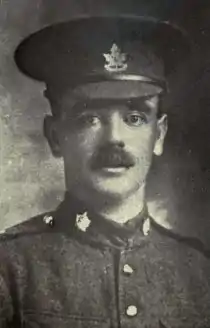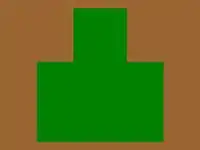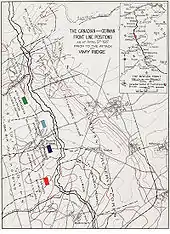50th Battalion (Calgary), CEF
The 50th Battalion (Calgary), CEF, was an infantry battalion of the Canadian Expeditionary Force during the Great War. The 50th Battalion was authorized on 7 November 1914 and embarked for Britain on 27 October 1915. The battalion disembarked in France on 11 August 1916, where it fought as part of the 10th Canadian Infantry Brigade, 4th Canadian Division in France and Flanders until the end of the war. The battalion was disbanded on 30 August 1920.[1]
| 50th Battalion, CEF | |
|---|---|
| Active | November 7, 1914 – August 30, 1920 |
| Country | Canada |
| Branch | Canadian Corps |
| Type | Line infantry |
| Role | Infantry |
| Size | 1 battalion (500–1,000 men) |
| Part of | |
| Garrison/HQ | Calgary |
| Nickname(s) | Mason's Man-Eaters |
| Colors | Oxford blue over Cambridge blue |
| March | "A Hundred Pipers" |
| Engagements | World War I |
| Battle honours | Somme, 1916; Ancre Heights; Ancre, 1916; Arras, 1917, '18; Vimy, 1917; Hill 70; Ypres, 1917; Passchendaele; Amiens; Scarpe, 1918; Drocourt-Quéant Line; Hindenburg Line; Canal du Nord; Valenciennes; France and Flanders, 1916–18 |
| Commanders | |
| Current commander | N/A |
| Colonel of the Regiment | Colonel E.G Mason (1915 – March 1917) Lieutenant-Colonel Page (March 1917 – November 1918) |
The 50th Battalion recruited in and was mobilized at Calgary, Alberta.[2]
Officers commanding
The 50th Battalion had four officers commanding:
- Lieutenant-Colonel E.G. Mason, 27 October 1915 – 11 November 1916
- Major R.B. Eaton, 11 November 1916 – 1 January 1917
- Major C.B. Worsnop, DSO, 1 January 1917 – 11 March 1917
- Lieutenant-Colonel Lionel Frank Page, DSO, 11 March 1917 – demobilization[3]
Victoria Cross

One member of the 50th Battalion was awarded the Victoria Cross. Private John George Pattison was awarded the medal for his actions on 10 April 1917 during the Battle of Vimy Ridge. He was subsequently killed in action at Lens, France, on 3 June 1917[4]
Operational history
Ancre Heights/Somme

The battalion was ordered to Ancre Heights[5] in October. Ancre Heights was the scene of Canada's first involvement in the Battle of the Somme,[6] which had begun on July 1 and which ultimately resulted in 25,000 Canadian casualties. Later, the 50th was ordered into the fighting and during the battle, the 50th Battalion's non-commissioned officers (NCOs) suffered heavily. Positioned in the second wave, they were killed by hidden German machine-gun posts that had been bypassed by the initial assault.[7]
Vimy Ridge
From the Somme, the battalion was moved northward to Artois in November 1916, where they spent their winter and Christmas preparing for the offensive against Vimy Ridge.[8] From January to March, the 4th Division's artillery provided part of the pre-battle barrage. In March, the Canadian Corps changed the commander of the battalion, as Colonel E.G. Mason was transferred to another battalion and replaced Lieutenant-Colonel Page. In April, the Canadians made their three-day offensive, starting the Battle of Vimy Ridge.

The 50th Battalion and the rest of the 4th Canadian Division were assigned to attack Hill 145. After many attempts to capture the hill, they finally managed to take it from the Bavarian Reserve force. For the next two days, the 4th Canadian Division and 50th Battalion tried to attack the little knoll known as the Pimple. Finally, the Bavarians, low on food and having suffered many casualties, surrendered the Pimple and retreated from Vimy. The 50th, having suffered heavy casualties, were taken out of the line and rested for a while.
Lens and Passchendaele
After Vimy the 50th Battalion, with the rest of the Canadian Corps, started preparations for the Battle of Hill 70.[9] They fought the Germans in the streets of Lens and in the generating plant, which a group of Germans had fortified. After a hard-fought battle there, the Canadians gained a reputation as elite or storm troops. During this battle, they were taken out of the line for a little bit, and put into billets. They stayed with French families in their remaining small houses.
Field Marshal Sir Douglas Haig then ordered them into the heavy fighting at Liévin and Hill 65 in June and July 1917. After suffering low casualty rates, the Canadians were ordered to one of the costliest battles in the war, the Third Battle of Ypres.[10] The Canadians suffered 16,000 dead and many more wounded, while 50th Battalion lost a quarter of their fighting men. The Canadian Corps was successful, however, capturing the village of Passchendaele. After the battle at Passchendaele, the Canadians finally got a break and they had Christmas dinner at Château de la Haie. During the initial stages of the German spring offensive that was launched in early 1918, the 50th Battalion, along with the other Canadian units, was out of the line conducting training and, as a result, missed the heaviest part of the fighting.
Kaiser's Battle
During this German offensive,[11] dedicated to the German Kaiser, the Germans managed to penetrate the Allied front lines and push them back almost all the way to Paris, but the Allies took advantage of the barrier provided by the Marne River situated just outside Paris, where they subsequently managed to halt the German advance. The Germans, wasted after having to sacrifice a large amount of their troops during the offensive, could not withstand the strong Allied push that followed and which ultimately brought about an end to the war.
Llandovery Castle operations
In 1918, a Canadian medical ship, HMHS Llandovery Castle was sunk by a German U-boat, even though Llandovery Castle had a white flag put up. The Canadians, furious with the Germans, started an offensive dedicated to Llandovery Castle. The 50th fought in Llandovery Castle operations,[12] during which they managed to liberate a few towns and villages.
Canada's Hundred Days
The German advance to Paris was halted by the Second Battle of the Marne. After years of stalemate on the Western Front, the war was finally coming to an end. In the last 100 days, the 50th Battalion fought at the Battle of Amiens on August 8–10; the Second Battle of the Somme (1918), which was also known as the Battle of Arras; the Battle of Cambrai, where they helped recapture Cambrai and hold it against German attacks; the battle of Drocourt-Quéant where the 50th Battalion helped to defeat the German defensive line; the Battle of the Canal du Nord, where the Canadian Corps, with 50th Battalion crossed the canal; and the Battle of Valenciennes, one of the last battles of the war, where Mons was captured. By then, the Germans were retreating from France and Belgium. On November 11, on the eleventh hour, the Germans agreed to an armistice, ending the First World War.
Perpetuation
The 50th Battalion (Calgary), CEF, is perpetuated by The King's Own Calgary Regiment (RCAC).[13]
Battle honours
The 50th Battalion was awarded the following battle honours:
Records
The history of the 50th Battalion is recorded in books and in letters that kept by their families or discovered by historians later in years. A few examples of members whose stories have been told are Richard Playfair[15] and Victor W. Wheeler.[16]
Notable 50th Battalion men
- Sergeant Edward Staves, Military Medal
- Private "Ducky" Henry Norwest (Sniper)
- Private Victor Wheeler (Signaller)
- Colonel E.G. Mason (commander)
- Colonel Page (commander)
- Private John George Pattison, VC
- Lieutenant Joseph Emmett Stauffer
Memorials
Soldiers of the 50th Battalion that went missing in action are memorialized on the Menin Gate and the Vimy Memorial. Soldiers of the battalion killed in action are commemorated on the Calgary Soldiers' Memorial, dedicated in April 2011. There is also a bridge over the Elbow River in Calgary named after John George Pattison, VC.[17]
Engagements
Training, 1914–1916
- Formation to August 1916: training in various places in Canada, Great Britain and France
Somme Front, 1916
- October 1 – November 11, 1916: the Battle of Ancre Heights
- July 1 – November 18, 1916: the Battle of the Somme
Vimy Front, 1917
- January–April, 1917: preparation for The Battle of Vimy Ridge
- April 9–12, 1917: the Battle of Vimy Ridge
Lens Front, 1917
- August 15–25: attack on Hill 70
Ypres Front, 1917
- July 31 – November 10, 1917: Third Battle of Ypres or the Battle of Passchendaele
Training, 1917–1918
- December 1917: Christmas at Château de la Haie
- January–July 1918: training in France
Hundred Days' Offensive, 1918
- August 8–11, 1918: the Battle of Amiens
- August 21 – September 2, 1918: the Second Battle of the Somme
- September 27 – October 1, 1918: the Battle of Canal du Nord
- October 8–10, 1918: the Battle of Cambrai
- November 11, 1918: the Battle of Valenciennes (also known as the Capture of Mons)
See also
- The Calgary Tigers football team was renamed Calgary 50th Battalion for the 1923 and 1924 seasons in the Alberta Rugby Football Union to commemorate the battalion.
- List of infantry battalions in the Canadian Expeditionary Force
References
- Citations
- Canadian Forces Publication A-DH-267-003 Insignia and Lineages of the Canadian Forces. Volume 3: Combat Arms Regiments.
- Meek, John F. Over the Top! The Canadian Infantry in the First World War. Orangeville, Ont.: The Author, 1971. ISBN 0906158109
- Meek, John F. Over the Top! The Canadian Infantry in the First World War. Orangeville, Ont.: The Author, 1971. ISBN 0906158109
- Meek, John F. Over the Top! The Canadian Infantry in the First World War. Orangeville, Ont.: The Author, 1971. ISBN 0906158109
- The 50th Battalion in No Man's Land, Chapter 5
- The 50th Battalion in No Man's Land, Chapter 6
- Canada, Veterans Affairs (2022-07-12). "The Canadian Corps and the Battle of the Somme - Veterans Affairs Canada". www.veterans.gc.ca. Retrieved 2023-10-25.
- The 50th Battalion in No Man's Land, Victor Wheeler, Chapter 10
- The 50th Battalion in No Man's Land, Victor Wheeler, Chapter 13
- The 50th Battalion in No Man's Land, Victor Wheeler, Chapter 15
- The 50th Battalion in No Man's Land, Victor Wheeler, Chapter 18
- The 50th Battalion in No Man's Land, Victor Wheeler, Chapter 20
- Canadian Forces Publication A-DH-267-003 Insignia and Lineages of the Canadian Forces. Volume 3: Combat Arms Regiments.
- Meek, John F. Over the Top! The Canadian Infantry in the First World War. Orangeville, Ont.: The Author, 1971. ISBN 0906158109
- "The Ross Playfair Letters Project". Retrieved 14 May 2013.
- Wheeler, Victor (2000). The 50th Battalion in No Man's Land: 50th Canadian Infantry Battalion (Alberta Regiment), Canadian Expeditionary Force, 1915–1919. CEF Books. ISBN 978-1-896979-15-1.
- ""Soldier led Vimy charge"". Archived from the original on 2011-07-08. Retrieved 2011-02-12.
Sources
- Canadian Expeditionary Force 1914-1919 by Col. G. W. L. Nicholson, CD, Queen's Printer, Ottawa, Ontario, 1962
Bibliography
- Wheeler, Victor W. (2000). The 50th Battalion in No Man's Land: 50th Canadian Infantry Battalion (Alberta Regiment), Canadian Expeditionary Force, 1915–1919 (illustrated ed.). CEF Books. ISBN 978-1-896979-15-1.
- Christie, Norm (2000). For King and Empire: The Battle of the Somme. Vol. 2 (illustrated ed.). CEF Books. ISBN 1-896979-03-3.
- Christie, Norm (2000). For King and Empire: The Battle of Vimy Ridge. Vol. 3 (illustrated ed.). CEF Books. ISBN 1-896979-07-6.
- Christie, Norm (2000). For King and Empire: The Battle of Passchendaele. Vol. 4 (illustrated ed.). CEF Books. ISBN 1-896979-05-X.
- Christie, Norm (2000). For King and Empire: The Battle of Arras. Vol. 5 (illustrated ed.). CEF Books. ISBN 1-896979-16-5.
- Christie, Norm (2000). For King and Empire: The Battle of Cambrai. Vol. 6 (illustrated ed.). CEF Books. ISBN 1-896979-18-1.
- Christie, Norm (2000). For King and Empire: The Battle of Amiens. Vol. 7 (illustrated ed.). CEF Books. ISBN 1-896979-20-3.
- Christie, Norm (2000). For King and Empire: The Battle of Ypres. Vol. 8 (illustrated ed.). CEF Books. ISBN 1-896979-01-7.